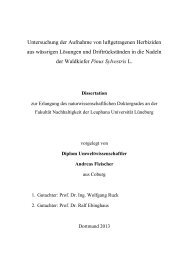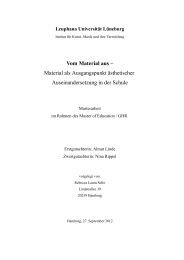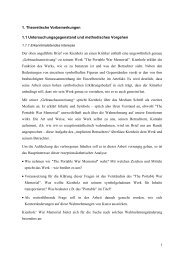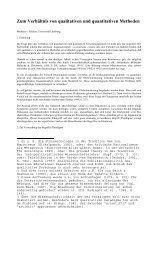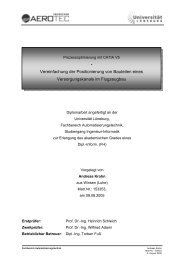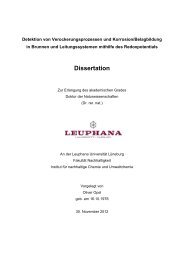Determinants of Emotional Experiences in Traffic Situations ... - OPUS
Determinants of Emotional Experiences in Traffic Situations ... - OPUS
Determinants of Emotional Experiences in Traffic Situations ... - OPUS
Create successful ePaper yourself
Turn your PDF publications into a flip-book with our unique Google optimized e-Paper software.
<strong>Emotional</strong> States <strong>of</strong> Drivers and Their Impact on Driv<strong>in</strong>g Behaviour 77<br />
drivers are prone to negative emotions <strong>in</strong> goal-block<strong>in</strong>g situations (e. g. impeded progress on the road<br />
or erratic driv<strong>in</strong>g <strong>of</strong> others; see Roidl, Frehse, Oehl & Höger, 2013), which could, <strong>in</strong> turn, lead to<br />
maladaptive driv<strong>in</strong>g behaviours (e. g. aggressive driv<strong>in</strong>g) (Philippe, Vallerand, Richer, Vallières &<br />
Bergeron, 2009).<br />
The implications <strong>of</strong> those emotions (anger and anxiety) <strong>in</strong> traffic are two-fold. Firstly,<br />
cognitive processes are <strong>in</strong>fluenced due to emotional experiences (Lazarus, 1991; Lerner & Keltner,<br />
2002) and, as a result, effectively <strong>in</strong>fluence driv<strong>in</strong>g behaviours. The appraisal tendency approach<br />
implies that experienced emotions and its associated appraisal components trigger an aligned<br />
evaluation <strong>of</strong> subsequent events. Negative moods, such as feel<strong>in</strong>gs <strong>of</strong> anxiety, appear to lead to<br />
pessimistic risk perceptions, as opposed to positive mood, which makes people more confident <strong>in</strong><br />
situation where they don’t have any control over the events (Johnson & Tversky, 1983). However,<br />
anger could lead to more perceived control and therefore to more optimistic risk appraisals (Lerner &<br />
Keltner, 2001); This translates <strong>in</strong>to the traffic context, that angry drivers are prone to underestimate<br />
risky situations and therefore change their behaviour <strong>in</strong> a maladaptive way (Mesken et al., 2007). They<br />
tend to show aggressive behaviours <strong>in</strong> traffic (e.g.; Lajunen & Parker, 2001; Björklund, 2008; Dahlen<br />
& White, 2006; Stephens & Groeger, 2009; Britt & Garrity, 2006) such as <strong>in</strong>creased speed<br />
(Deffenbacher et al., 2003; Matthews Desmond, Joyner, Carcary & Gilliland, 1997), traffic violations<br />
(Mesken et al., 2007; Maxwell, Grant & Lipk<strong>in</strong>, 2005; Sümer, 2003), (hostile) gestures (Philippe et al.,<br />
2009) and honk<strong>in</strong>g (Sh<strong>in</strong>ar, 1998; Philippe et al., 2009). Ultimately, these forms <strong>of</strong> behaviour <strong>in</strong>crease<br />
the risk <strong>of</strong> crashes and endanger other road participants (Deffenbacher et al., 2003; Chliaoutakis,<br />
Koukouli, Lajunen & Tzamalouka, 2002; Underwood et al., 1999).<br />
Accord<strong>in</strong>g to the appraisal tendency approach high levels <strong>of</strong> anxiety should lead to reduced<br />
speed and more cautious driv<strong>in</strong>g behaviour. But the literature shows different results: anxious drivers<br />
tend to perform even more risky and dangerous behaviours (Fairclough et al., 2006; Dula et al., 2010).<br />
One <strong>in</strong>terpretation might be, that anxiety works as restrict<strong>in</strong>g factor on overall work<strong>in</strong>g memory,<br />
which limits cognitive capacity that could otherwise be used for driv<strong>in</strong>g tasks (Shahar, 2009; Dula et<br />
al., 2010). This could trigger lapses, errors and violations while driv<strong>in</strong>g (Fairclough et al., 2006;<br />
Shahar, 2009; Taylor, Deane & Podd, 2007). The present study has pursued two different goals: first,<br />
the emotion-elicit<strong>in</strong>g potential <strong>of</strong> various situational factors with<strong>in</strong> traffic situations were tested.<br />
Accord<strong>in</strong>g to the appraisal theory framework, different comb<strong>in</strong>ations <strong>of</strong> situational factors should<br />
elicit different emotions. In this experiment, the focus was laid on anger, when the driver’s arrival or<br />
safety goal was blocked due to another driver (Park<strong>in</strong>son, 2001; Mesken et al., 2007; Roidl et al.,<br />
2013) and anxiety, when the driver’s security <strong>in</strong> traffic is at stake (Ehlers et al., 1994; Taylor, Deane &<br />
Podd, 2000; Roidl et al., 2013). A second aim was to evaluate the impact <strong>of</strong> emotions <strong>of</strong> anger and<br />
anxiety on driv<strong>in</strong>g behaviour <strong>in</strong> the simulator. Velocity, acceleration, lateral acceleration and speed<strong>in</strong>g<br />
were focused <strong>in</strong> this study due to their relevance <strong>in</strong> the literature <strong>of</strong> emotional driv<strong>in</strong>g (Stephens &<br />
Groeger, 2009; Cai & L<strong>in</strong>, 2011; Deffenbacher et al., 2003). Furthermore, driv<strong>in</strong>g accidents (with no<br />
other traffic participants <strong>in</strong>volved) due to maladaptive speeds contribute to 35% <strong>of</strong> all accidents and<br />
!



